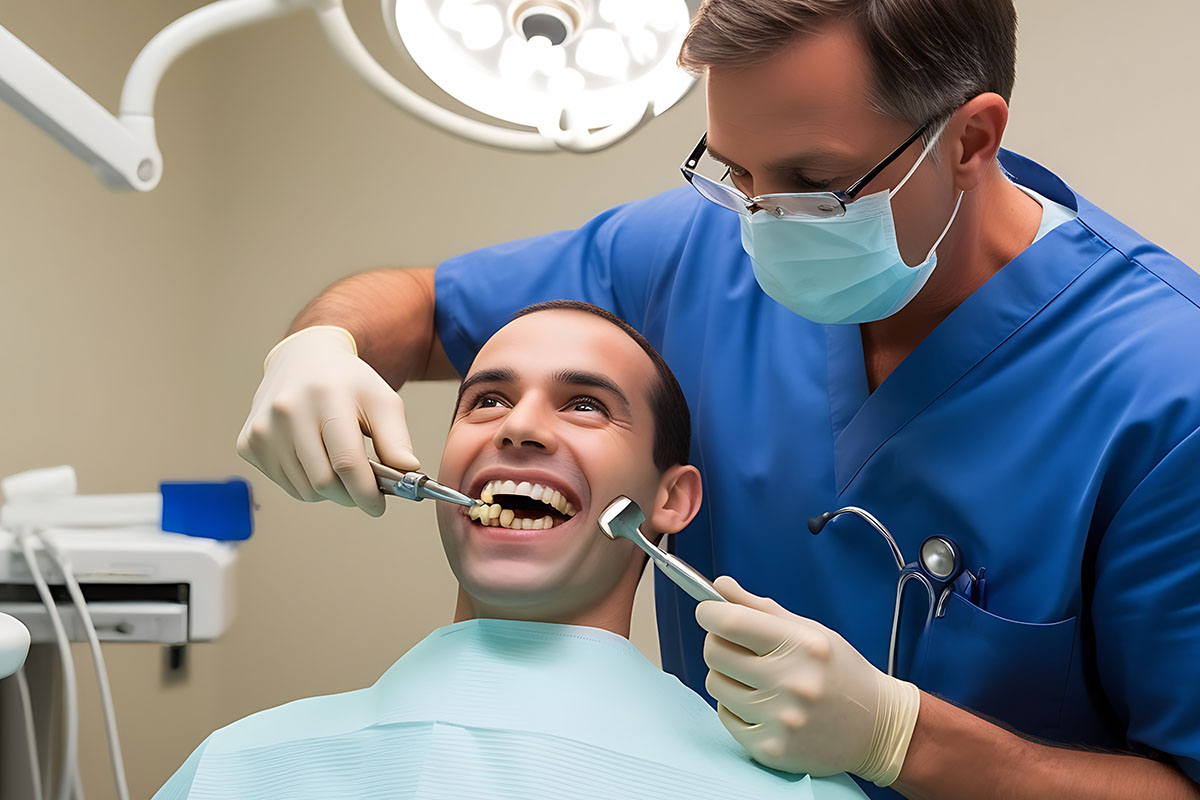




Gum disease, also known as periodontal disease, affects the tissues surrounding and supporting the teeth. It starts with gum inflammation (gingivitis) and can progress to more severe forms, potentially leading to tooth loss if untreated. Here’s an overview of the different types of gum disease and their treatments at our hospital:
Periodontitis is a more severe form of gum disease that occurs when gingivitis is left untreated. It causes damage to the tissues and bones supporting the teeth, leading to deeper pockets between the teeth and gums, gum recession, and tooth mobility.
Treatment:
Scaling and Root Planing: Deep cleaning below the gumline to remove tartar and smooth the roots of the teeth.
Antibiotics: May be prescribed to control infection.
Surgical Procedures: In advanced cases, flap surgery or bone and tissue grafts may be necessary to repair damage.
Prognosis:
Periodontitis can be managed with proper treatment, but the damage to bone and tissue may not be fully reversible.
Aggressive Periodontitis
Aggressive periodontitis is a rare but severe form of gum disease that affects young, otherwise healthy individuals. It can rapidly destroy gum tissue and bone, leading to tooth loss.
Treatment:
Scaling and Root Planing: Deep cleaning to remove plaque and tartar.
Systemic Antibiotics: Often needed to control bacterial infection.
Surgical Treatment: May include flap surgery, bone grafts, or tissue regeneration to restore damaged structures.
Regular Follow-ups: Close monitoring and maintenance are crucial.
Prognosis:
Aggressive periodontitis requires extensive treatment, and ongoing care is necessary to prevent further damage.
Chronic Periodontitis
Chronic periodontitis is the most common form of gum disease, typically seen in adults. It progresses slowly and can cause tooth loss if not addressed. It involves inflammation, deep gum pockets, and bone loss.
Treatment:
Scaling and Root Planing: To clean deep beneath the gumline.
Antibiotic Therapy: To reduce infection.
Surgical Treatment: In advanced cases, procedures like pocket reduction or tissue grafting may be necessary.
Prognosis:
With regular treatment and proper oral hygiene, chronic periodontitis can be managed, but the bone damage may not be reversible.
Necrotizing Periodontal Disease
This is a severe, rapidly progressing gum disease that causes the death of gum tissues, ligaments, and bone. It is often associated with systemic conditions like HIV, malnutrition, or severe stress.
Treatment:
Immediate Care: Cleaning and debridement of necrotic tissue.
Antibiotics: To treat infection.
Systemic Support: Treatment of underlying conditions like nutritional deficiencies or stress.
Surgical Intervention: In some cases, tissue regeneration or surgery may be necessary.
Prognosis:
Necrotizing periodontal disease requires urgent treatment to control infection and manage the underlying health issues.
Prevention and Maintenance
Proper Oral Hygiene: Brushing, flossing, and using an antimicrobial mouthwash.
Regular Dental Visits: Professional cleanings and exams.
Healthy Lifestyle: A balanced diet, quitting smoking, and managing conditions like diabetes can help prevent gum disease.
Early Intervention: Treating gingivitis early prevents progression to more severe forms.
A dental cleaning is a professional cleaning performed by a dental expert to remove plaque, tartar, and stains from the teeth. It helps maintain good oral hygiene and prevents gum disease and cavities.
Most people should get a dental cleaning every six months. However, some individuals may require more frequent visits depending on their oral health needs.
Dental cleaning is generally painless. You may experience some discomfort if you have sensitive gums or plaque buildup, but it should not be painful. If you’re feeling nervous or anxious, talk to the dental expert about ways to make you more comfortable.
Regular cleanings help prevent tooth decay, gum disease, and bad breath. Even if you brush and floss at home, professional cleaning is necessary to remove hardened plaque (tartar) that cannot be cleaned with regular brushing.
The cleaning process includes scaling (removing plaque and tartar), polishing, and flossing to remove any remaining plaque. Your hygienist will also inspect your gums for signs of disease and may take X-rays if necessary.
Typically, a dental cleaning takes about 30 to 60 minutes, depending on the extent of cleaning needed.
After your cleaning, it’s important to maintain good oral hygiene by brushing twice a day, flossing daily, and using mouthwash. Drink plenty of water and avoid sugary snacks to protect your teeth.
A dental cleaning helps remove plaque and tartar but cannot treat cavities or gum disease. If issues are discovered during the cleaning, your dentist will discuss further treatment options.
It’s generally safe to eat and drink after a dental cleaning, but you might want to avoid hot or cold foods for a short time if your teeth feel sensitive.
We always take care of your smile
(+91) 931 640 1074, (+91) 834 760 1064
The goal of our clinic is to provide friendly, caring dentistry and the highest level of general, cosmetic, and specialist dental treatments.
© Sevarth Smile Care 2025 All right reserved.